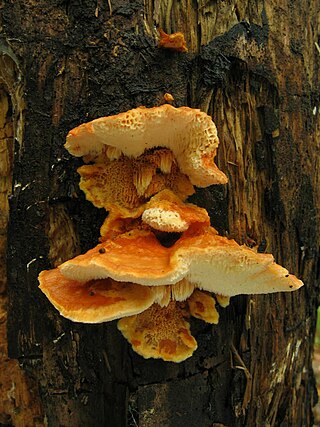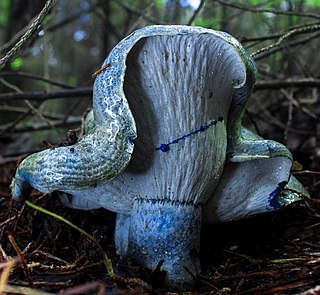
Postia tephroleuca, also known as greyling bracket, is a species of fungus in the family Fomitopsidaceae infecting broad-leaved trees, typically beech and plane.

The Fomitopsidaceae are a family of fungi in the order Polyporales. Most species are parasitic on woody plants, and tend to cause brown rots. The name comes from Fomitopsis + -aceae.

Postia is a genus of brown rot fungi in the family Fomitopsidaceae.

Apamea lateritia, the scarce brindle, is a moth of the family Noctuidae. It is found in much of the Palearctic. It is a sporadic migrant in Great Britain, where it is recorded from the east and south-east coasts.

The 33rd annual Cairo International Film Festival was held from November 10 to November 20, 2009. Indian director Adoor Gopalakrishnan was the president of the jury.
Marginella lateritia is a species of sea snail, a marine gastropod mollusk in the family Marginellidae, the margin snails.

George Edward Post (1838–1909) was an American surgeon, academic and botanist.
Aethes lateritia is a species of moth of the family Tortricidae. It was described by Razowski in 1970. It is found in Iran and Pakistan.
Metarctia lateritia is a moth of the subfamily Arctiinae. It was described by Gottlieb August Wilhelm Herrich-Schäffer in 1855. It is found in Angola, Botswana, Burundi, Cameroon, the Democratic Republic of the Congo, Eritrea, Eswatini, Ethiopia, Kenya, Lesotho, Malawi, Rwanda, South Africa, Tanzania, Uganda, Zambia and Zimbabwe.

Melaleuca lateritia, commonly known as the robin redbreast bush, is a plant in the myrtle family, Myrtaceae and is endemic to the south-west of Western Australia. It is also one of the most widely cultivated of the genus because of its attractive flowers which occur over a long period and for its adaptability to a range of climates. It is a medium-sized shrub normally 2–2.5 m (7–8 ft) high with coarse, fibrous bark.

In Finland, Kotiranta and Niemelä introduced a widely used method for comparing the conservation values of different forest areas, based on the observation that certain wood-rotting fungi are very sensitive to the impact of human activities on forest ecosystems. Such species are slow to return to areas from where they have disappeared, so their presence is evidence of a long continuity in forest ecosystems.

Aloe lateritia is an aloe widespread in open grassland and rocky bushland of East Africa.
Postia cylindrica is a species of poroid fungus in the family Fomitopsidaceae. Found in Southern China, it was described as a new species in 2017 by Hai-Sheng Yuan. The type collection was found growing on a dead pine tree in Jiangxi. The fungus is characterized macroscopically by crust-like to effused-reflexed fruit bodies with a cream to buff coloured cap surface and a reddish-brown margin that curves inward. There are gloeoplerous (oily) hyphal cells in the cuticular layer, and an absence of cystidia in the hymenium. The fungus produces smooth, cylindrical, thin-walled spores measuring 4.7–5.2 by 1.3–1.5 μm.
Postia duplicata is a species of poroid fungus in the family Fomitopsidaceae that was described as a new species in 2014. It is found in Yunnan and Zhejiang provinces of China, where it causes a brown rot on angiosperm wood. The fungus is named (duplicata) for its characteristic two-layered context, a feature that distinguishes it from other Postia species. The spores made by this fungus are cylindrical, hyaline, smooth, and typically measure 3.8–5.8 by 1.8–2.5 μm.
Postia amylocystis is a species of poroid fungus in the family Fomitopsidaceae. Found In China, the fungus was described as new to science in 1994 by mycologists Yu-Cheng Dai and Pertti Renvall. The original type collections were made in the Changbai Mountain Range, where the fungus was found growing on a decayed trunk of Manchurian lime. Characteristics that distinguish P. amylocystis from other Postia species include thick-walled cystidia in the hymenium, and narrow, sausage-shaped (allantoid) spores. The specific epithet amylocystis refers to the amyloid cystidia, and hints at a possible phylogenetic relationship to Amylocystis lapponica.

Kennedia lateritia, commonly known as Augusta kennedia, is a species of flowering plant in the family Fabaceae and is endemic to the south-west of Western Australia. It is a woody climber with twining stems, trifoliate leaves and orange-red and yellow flowers arranged in groups of up to twenty-four.
Postia leucomallella is a species of fungus belonging to the family Fomitopsidaceae.

Postia sericeomollis is a species of fungus belonging to the family Dacryobolaceae.

Hypomyces lateritius, the ochre gillgobbler, is a parasitic ascomycete fungus that grows on certain species of Lactarius mushrooms, improving their flavor and densifying the flesh. Hosts include L. camphoratus, L. chelidonium, L. controversus,L. deliciosus, Lactarius indigo, L. rufus, L. salmonicolor, L. sanguifluus, L. semisanguifluus, L. tabidus, L. trivialis, and L. vinosus.

Vampyrella lateritia is a freshwater species of predatory amoebae that feeds on species of algae and is known for its specialized feeding strategy of removing, digesting, and ingesting the cellular contents of its prey. It is the type species of the genus Vampyrella and has been identified in numerous locations around the world including Brazil, Germany, and the eastern United States. Along with Vampyrella pendula, its genome was sequenced in 2012.













